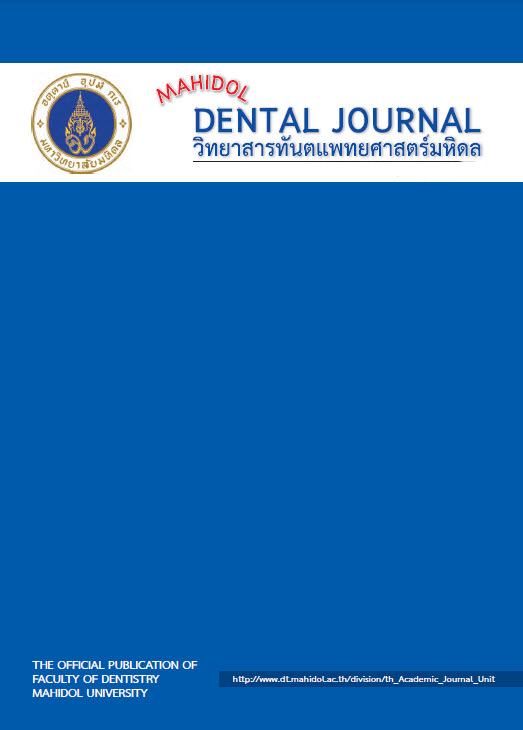The effect of silk fibroin hydrogel on proliferation of human stem cells from the apical papilla
Main Article Content
Abstract
Objectives : The aim of this study was to compare the efficiency of various concentrations of silk fibroin hydrogel as a scaffold Proliferation of Human Stem Cells from the Apical Papilla (SCAPs).
Materials and Methods : Silk fibroin hydrogel (SF) was prepared at the concentration of 1.5% w/v, 2.0% w/v, and 2.5% w/v. An individual SF was seeded with SCAPs at 50,000 cells. Subsequently, MTT assay was used to analyse cell proliferation after 1, 7, 14, and 21 days of culture. Finally, the morphological features of SCAPs cultured on SF were investigated by live/dead assay. The Tukcy HSD followed by Dunn test was preformed (P<0.05).
Results : On SF at concentration 1.5%, SCAPs proliferation rate was highest compared to SF at concentration 2.0% and 2.5% significantly (P<0.05). Moreover, SCAPs on 1.5% SF exhibited more extension of cytoplasmic process and interconnected with neighboring cells than other SF concentration.
Conclusion : The findings from the current study suggest that 1.5% SF had a favorable effect on SCAPs proliferation. Further studies are required to investigated cell differentiation and the effect of microenvironment (in vivo) on cell and scaffold behavior.
Keywords: tissue engineering, scaffold, silk fibroin, stemcell(s), stem cell(s) of apical papilla
Article Details
References
Hargreaves KM, Diogenes A, Teixeira FB. Treatment options: biological basis of regenerative endodontic procedures. J Endod. 2013; 39: S30-43.
Hargreaves KM, Giesler T, Henry M, Wang Y. Regeneration potential of the young permanent tooth: what does the future hold? J Endod. 2008; 34: S51-6.
Murray PE, Garcia-Godoy F, Hargreaves KM. Regenerative endodontics: a review of current status and a call for action. J Endod. 2007; 33: 377-90.
Ding RY, Cheung GS, Chen J, Yin XZ, Wang QQ, Zhang CF. Pulp revascularization of immature teeth with apical periodontitis: a clinical study. J Endod. 2009; 35: 745-9.
Nosrat A, Seifi A, Asgary S. Regenerative endodontic treatment (revascularization) for necrotic immature permanent molars: a review and report of two cases with a new biomaterial. J Endod. 2011; 37: 562-7.
Cehreli ZC, Isbitiren B, Sara S, Erbas G. Regenerative endodontic treatment (revascularization) of immature necrotic molars medicated with calcium hydroxide: a case series. J Endod. 2011; 37: 1327-30.
Vepari C, Kaplan DL. Silk as a Biomaterial. Prog Polym Sci. 2007; 32: 991-1007.
Kundu B, Kurland NE, Bano S, Patra C, Engel FB, Yadavalli VK, et al. Silk proteins for biomedical applications: Bioengineering perspectives. Progress in Polymer Science. 2014; 39: 251-67.
Ayub ZH, Arai M, Hirabayashi K. Mechanism of the Gelation of Fibroin Solution. Biosci. Biotech. Biochem. 2014; 57: 1910-2.
Yan LP, Oliveira JM, Oliveira AL, Caridade SG, Mano JF, Reis RL. Macro/microporous silk fibroin scaffolds with potential for articular cartilage and meniscus tissue engineering applications. Acta Biomater. 2012; 8: 289-301.
Mandal BB, Kundu SC. Cell proliferation and migration in silk fibroin 3D scaffolds. Biomaterials. 2009; 30: 2956-65.
Chao PHG, Yodmuang S, Wang X, Sun L, Kaplan DL, Vunjak‐Novakovic G. Silk hydrogel for cartilage tissue engineering. J Biomed Mater Res B Appl Biomater. 2010; 95: 84-90.
Zhang W, Ahluwalia IP, Literman R, Kaplan DL, Yelick PC. Human dental pulp progenitor cell behavior on aqueous and hexafluoroisopropanol based silk scaffolds. J Biomed Mater Res A. 2011; 97A: 414-22.
Riccio M, Maraldi T, Pisciotta A, La Sala GB, Ferrari A, Bruzzesi G, et al. Fibroin scaffold repairs critical-size bone defects in vivo supported by human amniotic fluid and dental pulp stem cells. Tissue Engineering Part A. 2012; 18: 1006-13.
Liu Y, Xiong S, You R, Li M. Gelation of <i>Antheraea pernyi</i> Silk Fibroin Accelerated by Shearing. Materials Sciences and Applications. 2013; 04: 365-73.
Yodmuang S, McNamara SL, Nover AB, Mandal BB, Agarwal M, Kelly TA, et al. Silk microfiber-reinforced silk hydrogel composites for functional cartilage tissue repair. Acta Biomater. 2015; 11: 27-36.
Samal SK, Kaplan DL, Chiellini E. Ultrasound Sonication Effects on Silk Fibroin Protein. Macromolecular Materials and Engineering. 2013; 298: 1201-8.
Fini M, Motta A, Torricelli P, Giavaresi G, Nicoli Aldini N, Tschon M, et al. The healing of confined critical size cancellous defects in the presence of silk fibroin hydrogel. Biomaterials. 2005; 26: 3527-36.
Wang X, Kluge JA, Leisk GG, Kaplan DL. Sonication-induced gelation of silk fibroin for cell encapsulation. Biomaterials. 2008; 29: 1054-64.
Floren M, Bonani W, Dharmarajan A, Motta A, Migliaresi C, Tan W. Human mesenchymal stem cells cultured on silk hydrogels with variable stiffness and growth factor differentiate into mature smooth muscle cell phenotype. Acta Biomater. 2016; 31: 156-66.


